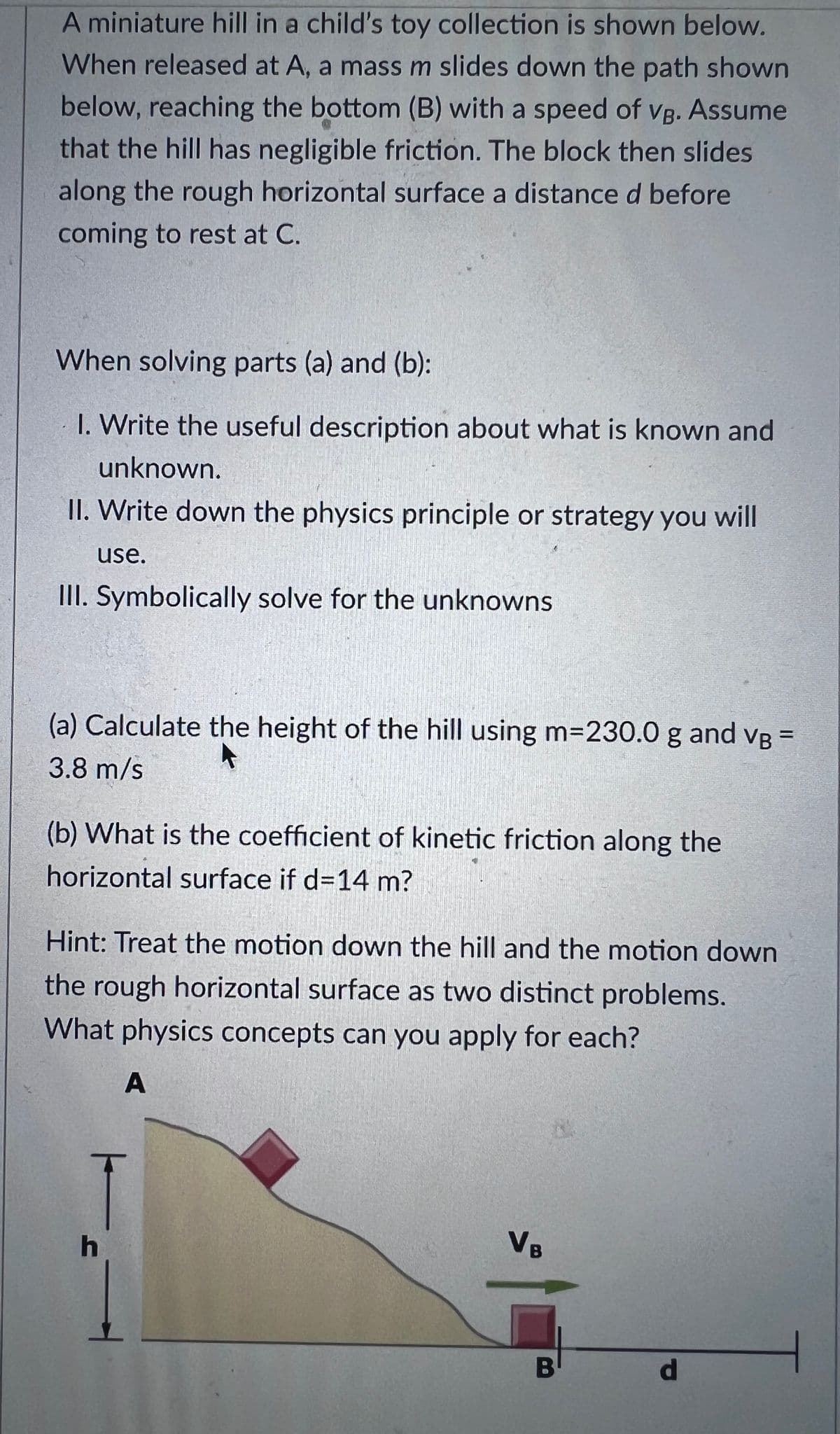(a) Calculate the height of the hill using m=230.0 g and VB = 3.8 m/s (b) What is the coefficient of kinetic friction along the horizontal surface if d=14 m?
(a) Calculate the height of the hill using m=230.0 g and VB = 3.8 m/s (b) What is the coefficient of kinetic friction along the horizontal surface if d=14 m?
University Physics Volume 1
18th Edition
ISBN:9781938168277
Author:William Moebs, Samuel J. Ling, Jeff Sanny
Publisher:William Moebs, Samuel J. Ling, Jeff Sanny
Chapter8: Potential Energy And Conservation Of Energy
Section: Chapter Questions
Problem 73AP: A mysterious force acts on all particles along a particular line and always points towards a...
Related questions
Topic Video
Question
Show all work please, I am so confused. Thank you!

Transcribed Image Text:A miniature hill in a child's toy collection is shown below.
When released at A, a mass m slides down the path shown
below, reaching the bottom (B) with a speed of VB. Assume
that the hill has negligible friction. The block then slides
along the rough horizontal surface a distance d before
coming to rest at C.
When solving parts (a) and (b):
I. Write the useful description about what is known and
unknown.
II. Write down the physics principle or strategy you will
use.
III. Symbolically solve for the unknowns
(a) Calculate the height of the hill using m=230.0 g and vB =
3.8 m/s
(b) What is the coefficient of kinetic friction along the
horizontal surface if d=14 m?
Hint: Treat the motion down the hill and the motion down
the rough horizontal surface as two distinct problems.
What physics concepts can you apply for each?
A
|▬▬▬
h
VB
B
d
Expert Solution
This question has been solved!
Explore an expertly crafted, step-by-step solution for a thorough understanding of key concepts.
Step by step
Solved in 2 steps

Knowledge Booster
Learn more about
Need a deep-dive on the concept behind this application? Look no further. Learn more about this topic, physics and related others by exploring similar questions and additional content below.Recommended textbooks for you

University Physics Volume 1
Physics
ISBN:
9781938168277
Author:
William Moebs, Samuel J. Ling, Jeff Sanny
Publisher:
OpenStax - Rice University

College Physics
Physics
ISBN:
9781305952300
Author:
Raymond A. Serway, Chris Vuille
Publisher:
Cengage Learning

Principles of Physics: A Calculus-Based Text
Physics
ISBN:
9781133104261
Author:
Raymond A. Serway, John W. Jewett
Publisher:
Cengage Learning

University Physics Volume 1
Physics
ISBN:
9781938168277
Author:
William Moebs, Samuel J. Ling, Jeff Sanny
Publisher:
OpenStax - Rice University

College Physics
Physics
ISBN:
9781305952300
Author:
Raymond A. Serway, Chris Vuille
Publisher:
Cengage Learning

Principles of Physics: A Calculus-Based Text
Physics
ISBN:
9781133104261
Author:
Raymond A. Serway, John W. Jewett
Publisher:
Cengage Learning

Classical Dynamics of Particles and Systems
Physics
ISBN:
9780534408961
Author:
Stephen T. Thornton, Jerry B. Marion
Publisher:
Cengage Learning